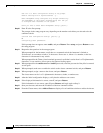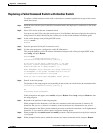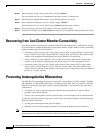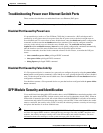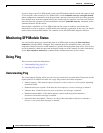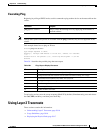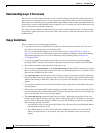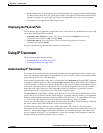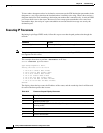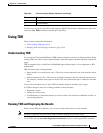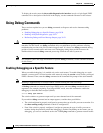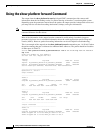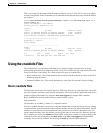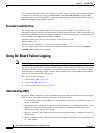
38-17
Catalyst 2960 and 2960-S Switch Software Configuration Guide
OL-8603-09
Chapter 38 Troubleshooting
Using IP Traceroute
• When multiple devices are attached to one port through hubs (for example, multiple CDP neighbors
are detected on a port), the Layer 2 traceroute feature is not supported. When more than one CDP
neighbor is detected on a port, the Layer 2 path is not identified, and an error message appears.
• This feature is not supported in Token Ring VLANs.
Displaying the Physical Path
You can display physical path that a packet takes from a source device to a destination device by using
one of these privileged EXEC commands:
• tracetroute mac [interface interface-id] {source-mac-address} [interface interface-id]
{destination-mac-address} [vlan vlan-id] [detail]
• tracetroute mac ip {source-ip-address | source-hostname}{destination-ip-address |
destination-hostname} [detail]
For more information, see the command reference for this release.
Using IP Traceroute
These sections contain this information:
• Understanding IP Traceroute, page 38-17
• Executing IP Traceroute, page 38-18
Understanding IP Traceroute
You can use IP traceroute to identify the path that packets take through the network on a hop-by-hop
basis. The command output displays all network layer (Layer 3) devices, such as routers, that the traffic
passes through on the way to the destination.
Your switches can participate as the source or destination of the traceroute privileged EXEC command
and might or might not appear as a hop in the traceroute command output. If the switch is the destination
of the traceroute, it is displayed as the final destination in the traceroute output. Intermediate switches
do not show up in the traceroute output if they are only bridging the packet from one port to another
within the same VLAN. However, if the intermediate switch is a multilayer switch that is routing a
particular packet, this switch shows up as a hop in the traceroute output.
The traceroute privileged EXEC command uses the Time To Live (TTL) field in the IP header to cause
routers and servers to generate specific return messages. Traceroute starts by sending a User Datagram
Protocol (UDP) datagram to the destination host with the TTL field set to 1. If a router finds a TTL value
of 1 or 0, it drops the datagram and sends an Internet Control Message Protocol (ICMP)
time-to-live-exceeded message to the sender. Traceroute finds the address of the first hop by examining
the source address field of the ICMP time-to-live-exceeded message.
To identify the next hop, traceroute sends a UDP packet with a TTL value of 2. The first router
decrements the TTL field by 1 and sends the datagram to the next router. The second router sees a TTL
value of 1, discards the datagram, and returns the time-to-live-exceeded message to the source. This
process continues until the TTL is incremented to a value large enough for the datagram to reach the
destination host (or until the maximum TTL is reached).




